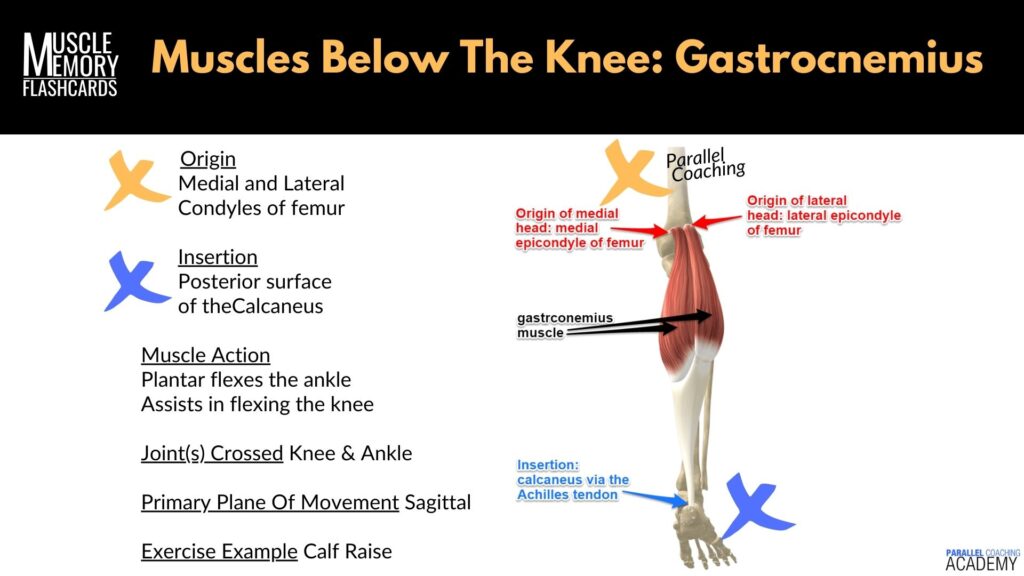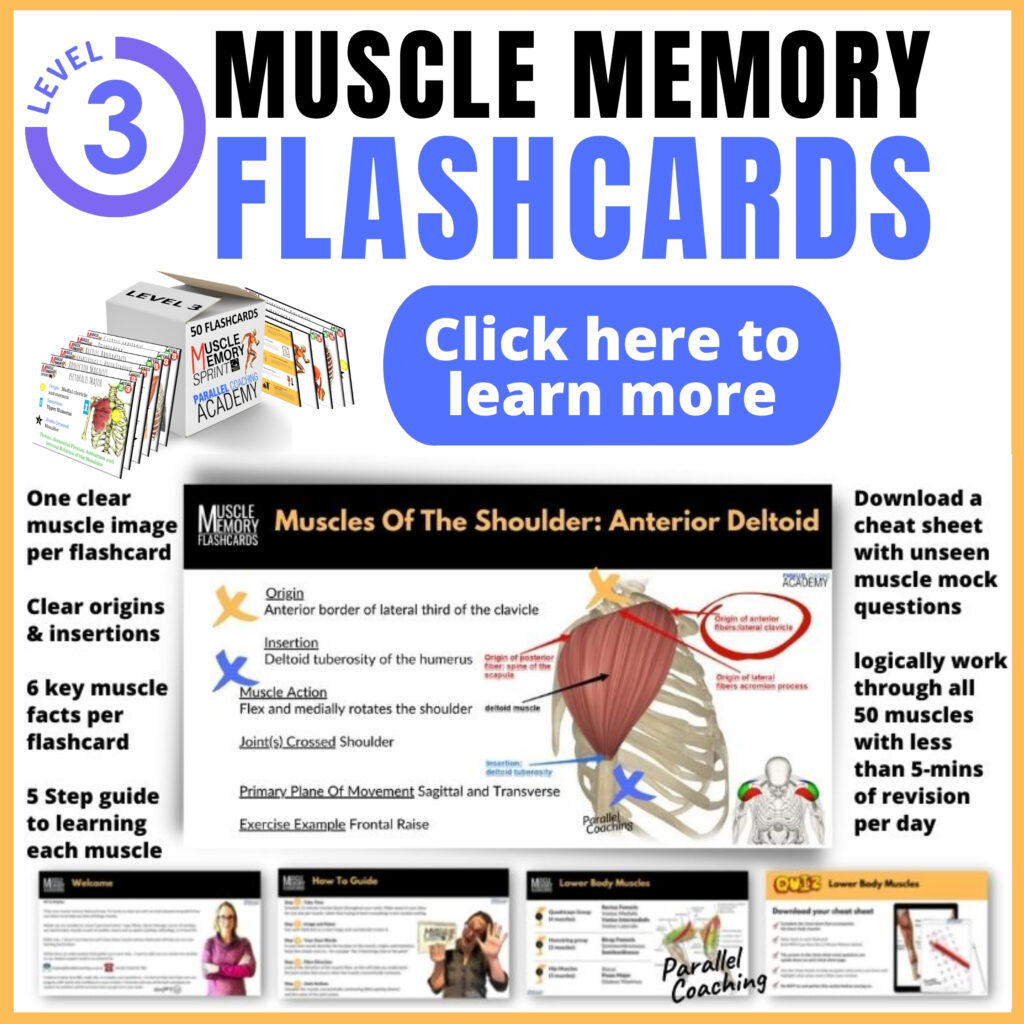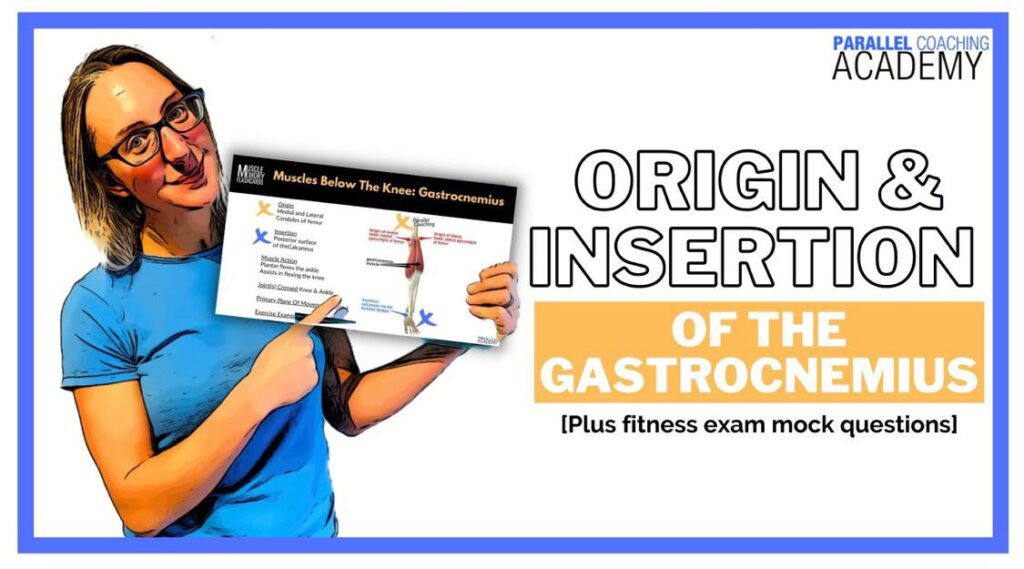In today’s video training, you’ll learn how to remember muscle origin and insertion of the Gastrocnemius ready for your Level 2 or Level 3 Anatomy and Physiology Exam
I’ll show you exactly how to remember complex information about the Gastrocnemius, including the origin and insertion, location, muscle action, and exercises that work the muscle. This means that you use a mix of visual and kinaesthetic learning to commit the facts to your memory and forge out a new neural pathway.
You can then use this same method of learning for all of the other muscles you need to learn for your Level 2 and Level 3 anatomy and physiology exam.
First of all, watch the 7-minute video tutorial and then test your knowledge using the three mock questions at the bottom of this blog.
Watch: The Origin and Insertion of the Gastrocnemius
Where is the Gastrocnemius?
The Gastrocnemius is more commonly known as the “Calf-muscle” and is positioned on the back of the lower leg.
What is the Origin and Insertion of The Gastrocnemius?
Origin: The Condyles of The Femur
Insertion: The Calcaneus via the Achilles Tendon
What is the Muscle Action of the Gastrocnemius?
The Gastrocnemius crosses the ankle and the knee, and therefore the joint actions of the Gastrocnemius are concerned with the movement of both the Knee and the Ankle
Exercises that work the Gastrocnemius include:
- Calf Raise – seated or standing
- Lunges
- Step-Ups
- Walking
- Running
Should the knee be flexed or extended on a calf raise?
The Gastrocnemius crosses the knee which means that to achieve maximum recruitment of the muscle the knee should be straight.
Therefore, when doing a calf raise, choose a standing option (rather than seated) to maximise the length of the muscle in the eccentric phase. The greater the length, the more ROM can be achieved, which in turn offers more recruitment.
5 simple steps to help you To Remember Muscle Origins and Insertions
This 5 step strategy will simplify and structure how you are learning the key muscle information. This is not only great for your exam but also when planning and working with clients.
Step 1: Take Time
Schedule 15-minute chunks spread throughout your week. Make space in your diary for one slot per muscle, rather than trying to learn everything in one revision setting.
Step 2: Image and Name
Use a clear image, like those in our L2/3 Flashcards, of the muscle you are learning. Ensure the name is clearly printed on the image to make it easy to commit to your visual memory.
Look at the image and close your eyes to see if you can remember the image and name together.
Here’s an example of the Gastrocnemius from our Muscle Memory Sprint Flashcards:
Yes – let me see the L2 Flashcards or L3 Flashcards

Step 3: Your Own Words
In your own words describe the location of the muscle and Origins and Insertions.
So for Gastrocnemius, I might say
“its my lower leg or calf. It originates just above my knee”
Then double-check the “official” terminology of the origin and insertion so you know for sure.
Step 4: Fibre Direction
Look at the direction of the muscle fibre, as this will help you understand the joint action that occurs when the muscle concentrically contracts.
So as the muscle shortens you can imagine the insertion being drawn closer to the origin.
Step 5: Joint Actions
Visualize the muscle concentrically contracting (fibres getting shorter) and the name of the joint action.
In my example, this would be Plantarflexion and Knee Flexion
Then pick an exercise that works this muscle. For example, To target the Gastrocnemius could choose the Calf Raise.
By repeatedly doing this exercise you can feel the muscle contracting and relaxing, which helps you to commit it to memory.
Test your knowledge with 3 Mock Questions
Look at the Muscle Anatomy and Physiology Mock questions below and jot down your answer on scrap paper or as a note in your phone.
Then scroll down to reveal the answers.
1) What action occurs when the muscle fibres of the Gastrocnemius concentrically contract?
A. Plantarflexion
B. Retraction
C. Dorsiflexion
D. Knee Extension
2) What is the insertion of the Gastrocnemius muscle?
A. Condyles of the Tibia
B. Calcaneus via the Longitudinal Ligament
C. Calcaneus via the Achilles Tendon
D. Condyles of the Femur
3) Which exercise does NOT work the Gastrocnemius muscle?
A. Calf Raise
B. Lateral Raise
C. Lunge
D. Walking
Answers:
Q1: Answer = A
Q2: Answer = C
Q3: Answer = B
If you want more mock questions like this, then you can download more Free Mock Questions: DOWNLOAD NOW
How to learn origins and insertions?
Learn, Revise & Remember All 50 Muscles In The Level 3 Anatomy & Physiology Exam.
(and the BEST part…You can do all this in as little as 5-minutes a day)
Each flashcard gives you a clear image and six clear muscle facts:
- Name and Location
- Origin and Insertions
- Muscle Actions
- Joints Crossed
- Primary Planes Of Movement
- Exercise Examples

Dedicated to More
Hayley “Origins and Insertions of the Gastrocnemius” Bergman
Parallel Coaching
P.S. You can also find us on the following platforms:
Instagram: Follow Now
Facebook: Like Our Page
Twitter: Tweet Us
YouTube: Subscribe Here
More Muscle Revision Blogs: HERE

